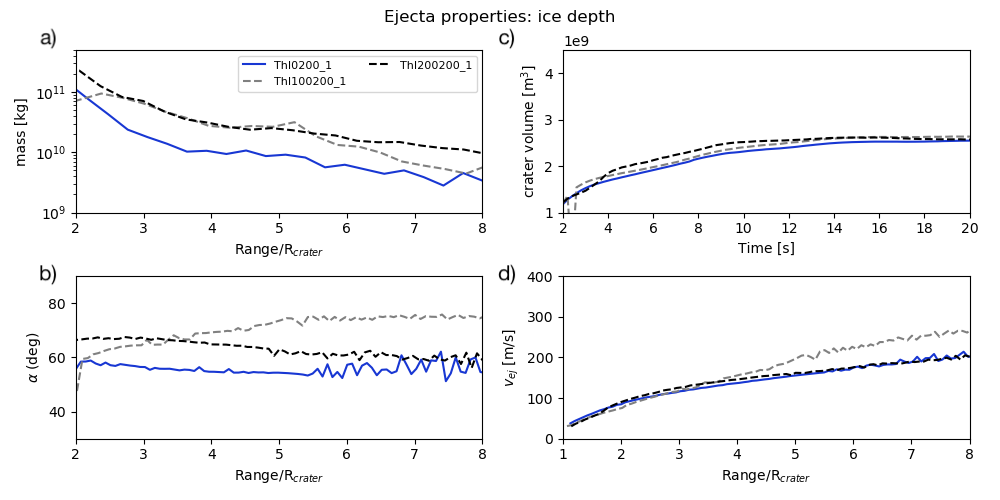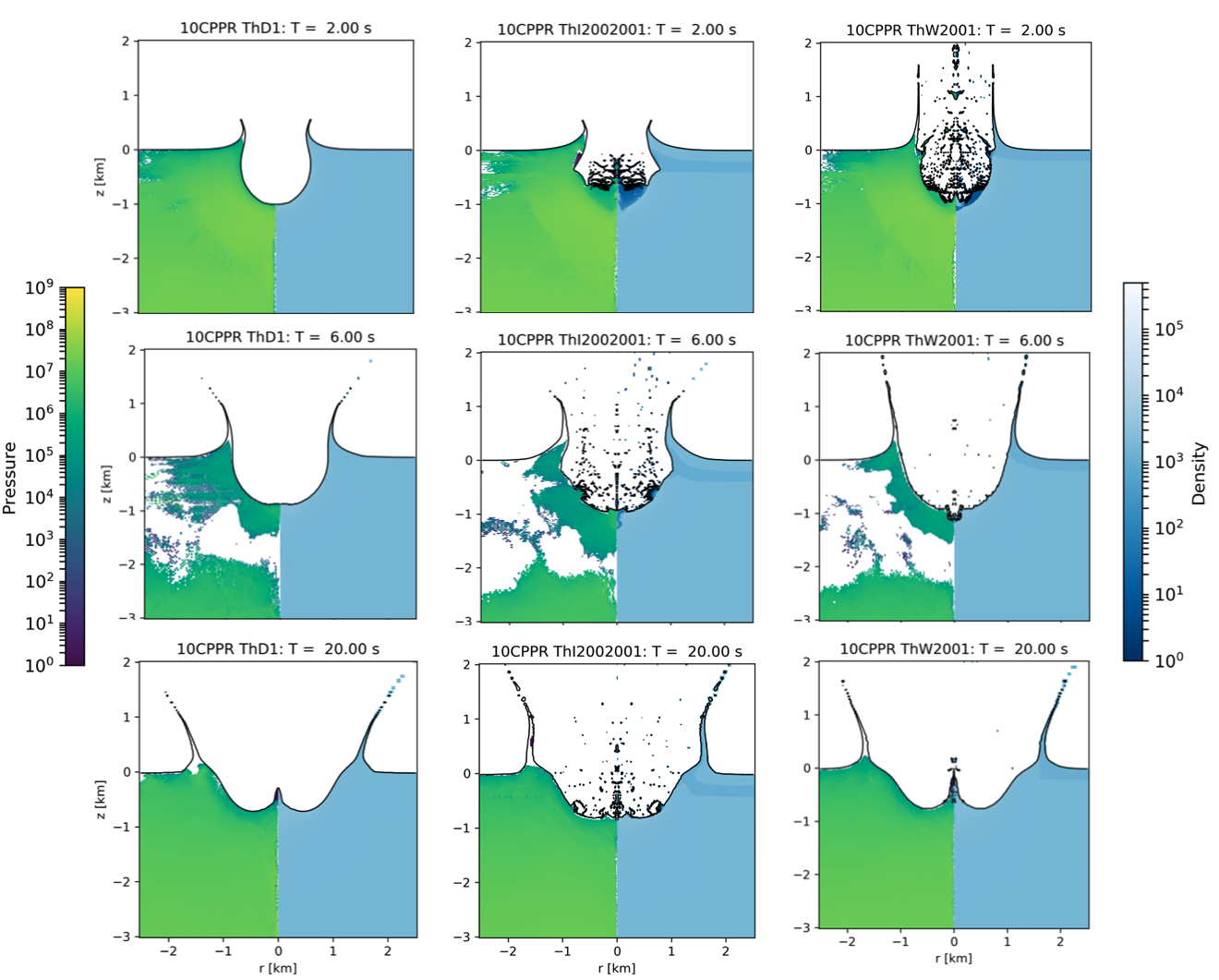Simulated craters and ejecta on the past Martian water- and ice-rich impact sites
- 1Department Space Research & Planetary Sciences, University of Bern, Bern, Switzerland (aleksandra.sokolowska@unibe.ch)
- 2Department Solar Systems, Impacts & Meteorites, Museum für Naturkunde Berlin, Leibniz-Institute for Evolution and Biodiversity Science, Berlin, Germany
Introduction
Mars is a cold dry planet, yet there is ample evidence for fluvial activity on its surface, which paints a different picture for its past climate [1]. If Mars has ever been covered by an ancient ocean or ubiquitous paleolakes, the signatures of the presence of water would have been preserved in the ejecta blankets of some impact sites because the thermodynamics of the excavation flow depends on the target material properties such as its composition and mechanical properties [2]. The main objective of this work is to test whether the difference between impact sites of water-covered, ice-rich, and dry target subsurfaces on Mars is significant enough to be observable.
Method
To simulate hypervelocity impact processes in solid materials, we use the iSALE-2D shock physics code [3,4,5]. Our simulations make use of its following models: the elasto-plastic constitutive model for multiple materials, the fragmentation and modified strength model, the porosity compaction model, and the acoustic fluidisation block model. Target materials are described by the ANEOS equations of state for basalt, water ice, and water.
We consider different impact scenarios with varied target composition: i) 200-400m of liquid water covering basalt, ii) 100-200m basalt surface covering 200-400m of subsurface water ice, iii) dry basaltic surface with no ice or water. The impact parameters are fixed across these scenarios: impacts are vertical and triggered by a single impactor with the impact velocity of 10km/s and the radius of 100m. The projectile is made of intact basalt described by the Lundborg strength model, while the the strength of the target basalt is described by the ROCK model, in which the yield strength is a function of both pressure and damage, with the latter computed by the iSALE damage model.
The full trajectories and final distribution of the impact ejecta have to be quantified in post-processing due to the fact that high above the crater, ejecta becomes underresolved in the Eulerian grid. We thus analyse the characteristics (i.e. velocity, launch time, launch position) of tracer particles when they reach an altitude of one projectile radius above the surface [2]. We then calculate their final landing positions, assuming ballistic trajectories, and analyse the ejecta mass distributions.
Results
|
|
|
Figure 1. Pressure and density maps of different impact scenarios shown at the resolution of 10CPPR (cells per projectile radius). The naming of the scenarios is as follows: ThD1: dry case of pure basalt, ThI200200: 200m of basalt covering 200m of water ice over basalt; ThW200: 200m of water over basalt. |
In Figure 1 we present different impact scenarios at 3 distinct periods of the excavation stage: 2s, 6s and 20s after the impact. The presence of water or water ice modifies the volume of the cavity during the entire excavation phase. The shapes and angles of the ejecta curtains are also different for varied target scenarios.
|
|
|
Figure 2. The evolution of crater volumes and radii over time. |
In Figure 2 we show the time evolution of the crater volumes and radii quantitatively. The most striking difference is between the volume of the excavated material in dry vs. ice-rich or water-rich targets, which translates into the difference in volumes of the ejecta blanket. Crater radii are also a discriminator between those cases, with water-covered and ice-rich targets being deeper than the “dry” one. However, over time their depth would also be decreased by the sublimation of subsurface ice and evaporation of the surface water.
 |
| Figure 3. Ejecta properties for the cases with varied ice depth. a) Mass distribution of ejected material. b) Dependency of the median ejection angle of the target material on where it landed. c) Evolution of the crater volume over time. d) Dependency of the ejection velocity of target material on where it landed. Rcrater were computed at t=20s. |
In Figure 3 we compare the ejection properties for targets with 200m ice at different depths: 0m (ThI0200); 100m (ThI100200) and 200m (ThI200200) depths. The final mass distributions and ejection angles are substantially different between these cases, and those differences would be reflected in the morphologies of the ejecta blankets. The final crater volumes (c) alone are insufficient to discriminate between these cases.
Conclusion
We conducted numerical experiments of impact cratering into varied targets: ice-rich, water-rich and dry (pure basalt). Our preliminary results show that for the constant projectile and velocity, one can discriminate between those cases based on the crater size and ejecta volume. We also show that the depth of buried ice would leave a characteristic signature in the blanket.
Future work
We plan to address the effects of the atmosphere and vapour plumes on the trajectories of ejecta. The interaction of ejected material with an atmosphere, accounting for drag forces and momentum exchange, was recently implemented in iSALE [6].
References
[1] Zachary I Dickeson, Joel M Davis, Martian oceans, Astronomy & Geophysics, Volume 61, Issue 3, June 2020, Pages 3.11–3.17, https://doi.org/10.1093/astrogeo/ataa038
[2] Luther, R., Zhu, M.-H., Collins, G. and Wünnemann, K. (2018), Effect of target properties and impact velocity on ejection dynamics and ejecta deposition. Meteorit Planet Sci, 53: 1705-1732. https://doi.org/10.1111/maps.13143
[3] Amsden, A., Ruppel, H., and Hirt, C. (1980). SALE: A simplified ALE computer program for fluid flow at all speeds. Los Alamos National Laboratories Report, LA-8095:101p. Los Alamos, New Mexico: LANL.
[4] Collins, G. S., Melosh, H. J., and Ivanov, B. A. (2004). Modeling damage and deformation in impact simulations. Meteoritics and Planetary Science, 39:217--231.
[5] Wünnemann, K., Collins, G., and Melosh, H. (2006). A strain-based porosity model for use in hydrocode simulations of impacts and implications for transient crater growth in porous targets. Icarus, 180:514--527.
[6] Robert Luther, Natalia Artemieva, Kai Wünnemann, The effect of atmospheric interaction on impact ejecta dynamics and deposition, Icarus, Volume 333, 2019, Pages 71-86, https://doi.org/10.1016/j.icarus.2019.05.007.
How to cite: Sokolowska, A., Thomas, N., Wünnemann, K., and Luther, R.: Simulated craters and ejecta on the past Martian water- and ice-rich impact sites, Europlanet Science Congress 2022, Granada, Spain, 18–23 Sep 2022, EPSC2022-1037, https://doi.org/10.5194/epsc2022-1037, 2022.


